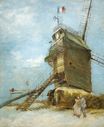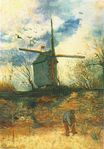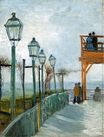Винсент Ван Гог - Мулен де ла Галетт 1886
 |
 |
 |
 |
 |
 |
 |

Мулен де ла Галетт 1886
61x50см холст/масло
Buenos Aires, Museo Nacional de Bellas Artes
<< Previous G a l l e r y Next >>
From Museo Nacional de Bellas Artes, Buenos Aires:
Vincent van Gogh came to paint this Moulin de la Galette (The Blute-Fin Windmill, Montmartre) in quite particular conditions that might well qualify as a transition, and the work fits within a series of views he produced of Paris. The Dutch artist arrived in France’s capital in March of 1886. There he contacted his brother Theo—without any prior notice—who had already spent seven years based in Paris, managing a small gallery on Montmartre Boulevard on behalf of Boussod et Valadon.
Van Gogh paints his Moulin while in a state of amazement, impacted by the surrounding artistic context, which was of unusual density: Moréas’ symbolist manifesto, the latest
impressionist exhibition (in which Seurat presented La Grande Jatte), Rimbaud’s Illuminations and L’oeuvre (The Masterpiece) by Zola all crowded into the local cultural scene.
He was also discovering the city’s charm: its arcades, animated conversations in its cafés and the works at the Louvre, a museum he would visit frequently. To top it all off,
he added an academic touch in the midst of this frenzy by enrolling as a student in the very classical Cormon studio, to hone his technical skills. There he alternated with
Toulouse-Lautrec and Anquetin.
It is well known that Van Gogh set out upon his career with a determination that was as humble as it was profound, and the months he spent in Paris undoubtedly awakened a
powerful inner desire to create. The Butte Montmartre was part of his everyday life, given that he stayed in Theo’s house, located in that neighborhood. Although the ties
between the two brothers were indeed very strong, in Fall of 1886 the promiscuity that prevailed at 54 Lepic Street—from which the panoramic view of the city was magnificent—began
to weigh on him. This led Vincent to replace still lives, painted inside the apartment, with landscape. At the outset, this impulse drove him to represent the immediate
surroundings, and as such, Montmartre .